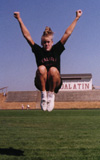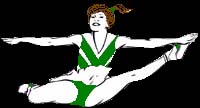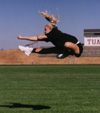Jumps!

Welcome to my jump page! When you begin a jump, you should start with your arms in a high V and your feet together. Cross your arms above your head and bring them forward and down to your knee level. Then uncross and hit a t motion as you jump up. Hint~When you uncross your arms when you jump, push up with your shoulders. You can somehow get higher.
Here are explainations and tips on how to do some of the most popular cheerleading jumps. Remember there is no trick to suddenly get awesome jumps, it takes hard work! So to get ready from tryouts, PRACTICE!!! First! Before you start doing any jumps you need to be completely stretched out....including the upper body! After you have stretch jump up and down a few times. Now you're ready to jump!
Jump Drill - If you have bad landings, these help a lot. Do a T and kick a leg out to the side like in a toe touch and keep the proper form. Now whip your leg down as fast as you can. Think you need to get your leg down twice as fast as you got it up there. Do this twice as many times on your bad leg.
The Prep: In your prep you need to put your arms in a high V then swing them down in front of you. Your legs should come up at the same time as your arms. When your legs reach the highest point in the jump, your arms should hit a motion.
Here are the counts along with the prep motions: ~1-2: hands are in a clasp(clap) ~3-4: hands are in a high-V, you are up on your toes ~5: hands swing down in front of you ~6: hands hit a motion ~7-8: hands come down to your sides, legs are bent to absorb jump
Beginner Jumps: Tuck - When you jump, lift legs and bring knees to chest. DO NOT bring your chest down to your knees. Keep your knees and feet together.
When you jump, lift legs and bring knees to chest. DO NOT bring your chest down to your knees. Keep your knees and feet together.
 When you jump lift right leg up and bend you knee so that it is level to the ground and your knee is pointing to the audience. Bring your back leg up and level to the ground and point your knee to the left. You should be able to sit in this position.
When you jump lift right leg up and bend you knee so that it is level to the ground and your knee is pointing to the audience. Bring your back leg up and level to the ground and point your knee to the left. You should be able to sit in this position.
- Spread Eagle -
 When you jump, lift both legs out to the side, but keep your knees facing forward. Spread them out to the side as far as you can. At the peak of your jump, hit a high V.
Intermediate Jumps:
When you jump, lift both legs out to the side, but keep your knees facing forward. Spread them out to the side as far as you can. At the peak of your jump, hit a high V.
Intermediate Jumps:
 This is similar to the herkie. When you jump, lift your right leg the same way as the herkie. Bring your left foot up like the left foot in the double hook.
This is similar to the herkie. When you jump, lift your right leg the same way as the herkie. Bring your left foot up like the left foot in the double hook.
 You should perform this jump at a 45 degree angle from the crowd. When you jump, lift your leg forward as high as you can and lift your back leg up like the left leg of a herkie. At the peak of your jump, your arms should be in a touchdown.
Advanced Jumps:
Toe Touch -
You should perform this jump at a 45 degree angle from the crowd. When you jump, lift your leg forward as high as you can and lift your back leg up like the left leg of a herkie. At the peak of your jump, your arms should be in a touchdown.
Advanced Jumps:
Toe Touch -  This is similar to the Spread Eagle. When you lift your legs up, make your knees point up and at the peak of your jump roll your hips back. Make sure you keep your back straight and don't hunch over.
This is similar to the Spread Eagle. When you lift your legs up, make your knees point up and at the peak of your jump roll your hips back. Make sure you keep your back straight and don't hunch over.
 This jump is difficult for me. Lift both of your legs forward until they are parallel to the ground. This is one of the few jumps that you are supposed to lean forward in. Put your arms straight out in front of your, on the outside of your heels. A good way to get a
high pike is to sit on the floor with your legs straight out in front of you
and touch your nose to your knees, or you can pull on your feet, then point
your toes. This jump is a 7/10 difficulty, and is a good competition jump.
Double
pikes are also a good competition jump, especially for individuals.
This jump is difficult for me. Lift both of your legs forward until they are parallel to the ground. This is one of the few jumps that you are supposed to lean forward in. Put your arms straight out in front of your, on the outside of your heels. A good way to get a
high pike is to sit on the floor with your legs straight out in front of you
and touch your nose to your knees, or you can pull on your feet, then point
your toes. This jump is a 7/10 difficulty, and is a good competition jump.
Double
pikes are also a good competition jump, especially for individuals.
 This is similar to the pike. You lift your right leg like the pike, and bend your left leg in towards you, level with the ground, your left toe touching your right knee. Your arms do the same..."double nine."
This is similar to the pike. You lift your right leg like the pike, and bend your left leg in towards you, level with the ground, your left toe touching your right knee. Your arms do the same..."double nine."
JUMP PRATCICE OUTLINE
Jump Practice:
- 1. Stretch
- 2. Have the squad warm up their jumps on their own.
- 3. Bring the squad together and do the jumps as a group to counts. Begin with the easiest and end with the most difficult. If some squad members cannot do a particular jump, encourage them to try anyway. They will never learn unless they try!
- 4. Play music and have the whole squad do the jumps together to the counts of the music. This is a great exercise to keep everyone synchronized.
- 5. Have the squad get into a circle. If the squad is very large, break it into groups. With the circles, have the members practice their jumps all together. By doing jumps in a circle, they can see if their timing is on or off. It is another great exercise to increase synchronization.
- 6. With the music playing, have the squad members line up in three or four
lines, depending on the size of the squad. The front people in each line will do a specified jump to the music. The coach should call out the jump and count out loud, so the front girls know what they are doing and when to execute that particular jump. Once their jump is over, they should run to the back of the line, while the rest of the squad moves forward.
















 Click here for tumbling!
Click here for tumbling!

